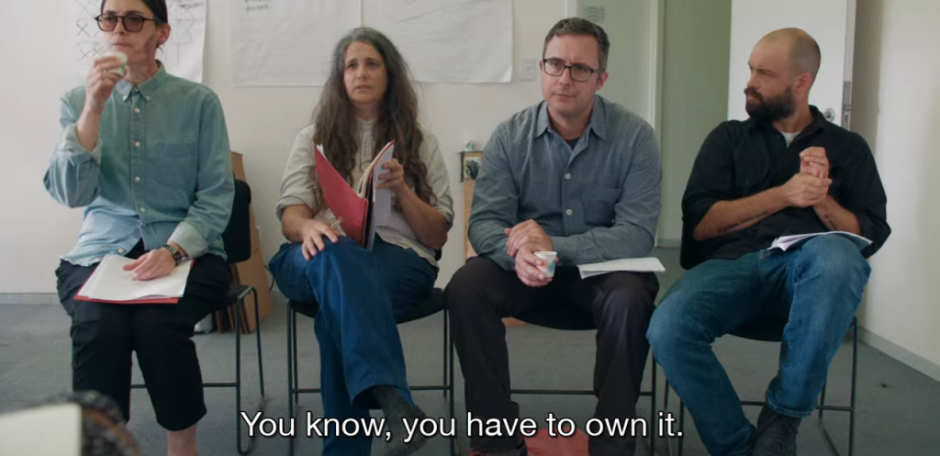Teaching Context
As a 0.8 on the Chelsea BA FA, I’m a tutor group leader for Year 3, I manage 31 students, oversee open sessions, lectures, admin, and curriculum planning for the entire cohort. I’m also involved in the revalidation of our course.
Evaluation
The BAFA course at Chelsea is adapting to the post-Covid/austerity/Gove education landscape. (Davies, 2022) Our student numbers grew dramatically during the pandemic due to online learning, and we currently have 168 students in Year 3. Since Covid, we’ve seen a decline in reading and public speaking skills, low attendance, and fewer foundation students. These challenges intersect with various social factors like class, disability, and race.
Rather than viewing these students as “lacking,” we decided to redesign the course to engage with them as they are. Our focus shifted to what we want students to learn and develop, rather than insisting on traditional forms of teaching that no longer seem effective.
A key issue we identified was the poor attendance of our lecture programme. Last year, attendance dropped to fewer than ten students after the first three sessions. We realised that the lectures assumed a shared knowledge base that students lacked, which made neurodiverse students specially anxious. The sessions were too long, struggled to capture attention, and didn’t connect directly to their work.
Implications and Actions
This year, we took a new approach: we shortened the Year meeting to 15-20 minutes, using the remaining time for a short, focused lecture on essential assessment skills (e.g., reading, writing, citations, risk assessment). The lectures provide an undercover excuse to bring art and theory examples and references in a more light-hearted way. Afterward, a 15-minute break is followed by an optional 90-minute post-lecture seminar, which explores these topics further through workshops, open discussions, and screenings.
For instance, a sound-focused session (relevant for sound-based dissertations) explored the history of art dematerialization and its links to decolonization theory in Peru. The post-seminar included sound essays and podcasts, featuring diverse young artists who are open about their DIY approaches and the support networks they rely on. We also invited our sound technician to showcase the underused podcast studio, which helped alleviate anxiety for students who feel intimidated by unfamiliar spaces or faculty.
My year leader and I co-run the year meetings, lectures, and seminars, purposefully allowing for disagreements to emerge. This creates opportunities for students to see how moments of not-knowing and disagreement can be productive, engaging, and normal in academic life.
Next Steps
The response from students, particularly neurodiverse students, has been positive, with attendance improving significantly. Around 50-60 students attend the lectures, and about 10/20 stay for the post-seminar. However, this is still not enough.
We’ve noticed a positive impact on students’ research skills and non-traditional dissertation formats (e.g., sound essays, video essays, experimental writing). While it’s too early to assess the long-term impact, we plan to evaluate the outcomes after assessments.
For next year, I proposed using an object-based learning approach, focusing each lecture on a single object. This would give students a concrete base from which to explore more abstract concepts. This model, which was discussed in our PGCert readings (Willcocks and Mahon, 2023), aims to help students develop familiarity and depth of understanding. My year leader suggested that using one object over two or three sessions might help students shift from a project-based to a practice-based approach in Fine Arts (Hughes, 2014).
References:
Davies, W. (2022) ‘How many words does it take to make a mistake?’, London Review of Books, 24 February. Available at: https://www.lrb.co.uk/the-paper/v44/n04/william-davies/how-many-words-does-it-take-to-make-a-mistake (Accessed: 13 February 2024).
Hughes, D. (2014) ‘Dwelling as an approach to creative pedagogy’, Art, Design & Communication in Higher Education, 13(1), pp. 73–85. Available at: https://doi.org/10.1386/adch.13.1.73_1.
Willcocks, J. and Mahon, K. (2023) ‘The potential of online object-based learning activities to support the teaching of intersectional environmentalism in art and design higher education’, Art, Design & Communication in Higher Education, 22(2), pp. 187–207. Available at: https://doi.org/10.1386/adch_00074_1.
